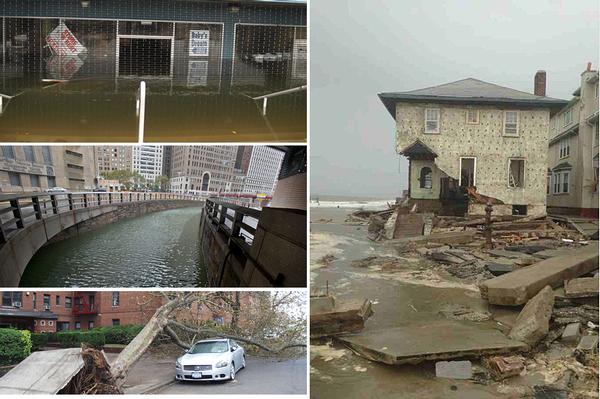
Photo by: Vicpeters, MTA, Proud Novice
A business on Emmons Avenue, the Hugh Carey Tunnel, a street tree and a seaside home reflect Sandy’s fury.
At 11 a.m. last October 24, the National Hurricane Center announced that Tropical Storm Sandy had just reached hurricane strength as it spun about 65 miles south of Kingston, Jamaica. On the U.S. East Coast, the hurricane watch zone was stretched north—but only as far as Florida’s Volusia/Brevard County line. It would be days before the threat to the New York City metropolitan area was clear.
Almost exactly a year later, political and philanthropic leaders in Brooklyn gathered Thursday with representatives of the hardest-hit communities in the borough to discuss what’s changed, for better or worse, since Sandy hit last October 29—and, especially, since public attention moved away from the recovery effort in early 2013.
That comeback effort continues in places like Gerritsen Beach, Sheepshead Bay, Coney Island, Brighton Beach and Red Hook.
“Their fight isn’t over,” said Brooklyn Community Foundation president Cecilia Clarke, “and they are not fighting alone.”
In concert with the Brooklyn Borough President’s Office and Brooklyn Chamber of Commerce, BCF launched the Brooklyn Recovery Fund in the wake of the storm. It’s raised $3.5 million so far, with particularly large grants from the Red Cross and Atlantic Yards developer Forest City Ratner.
As the Sandy anniversary approaches, so does a new mayoral administration, meaning the cast of officials dealing with recovery will soon turn over. Hoping to chronicle post-storm needs in the borough and inform those incoming leaders, the Recovery Fund is researching the six impact communities and will release a report late this year.
A key finding so far, said Clarke, is that communities with pre-existing organizations responded more effectively to the storm that neighborhoods that didn’t have that infrastructure.
But a neighborhood needs more than a network. “They have ideas and local knowledge,” Clarke added, “but they need more resources.”
Indeed, Assemblyman Nick Perry, whose district includes Canarsie, says people he represents have been “mistreated in this process and excluded from funding.”
A lesson Chamber of Commerce head Carlo Scissura took from the aftermath in Sandy is that aid programs tooled to assist small business owners—which are of limited effect in their own right—need to recognize that business owners are often the same people who lose their homes in a disaster.
Challenges for those communities will only grow if new federal flood insurance requirements are imposed, Mayor Bloomberg said on Friday.
He released a RAND study that found 35 percent of homeowners now required to get flood insurance don’t have it, and that average premiums could jump from “from an average of $430 to $5,000 to $10,000 per year.” City Hall says the expanded insurance requirements, while worthy, shouldn’t be implemented until there’s a mechanism in place to help homeowners who can’t afford the hike.
“Cost increases of this size would pose economic hardships for many households in the city,” the RAND report reads. “About 37 percent of households living in owner-occupied units in the floodplain earn less than $75,000 per year. A $5,000 premium would amount to 6.6 percent of a $75,000 annual income. … These consequences could make it impossible for some homeowners to stay in their homes.”
Also Friday, the mayor extended again an executive order dealing with debris removal initially issued after the storm. Among other things, the order permits city agencies to “enter private residential property as needed to remove debris” in accordance with a similar order from the state.







